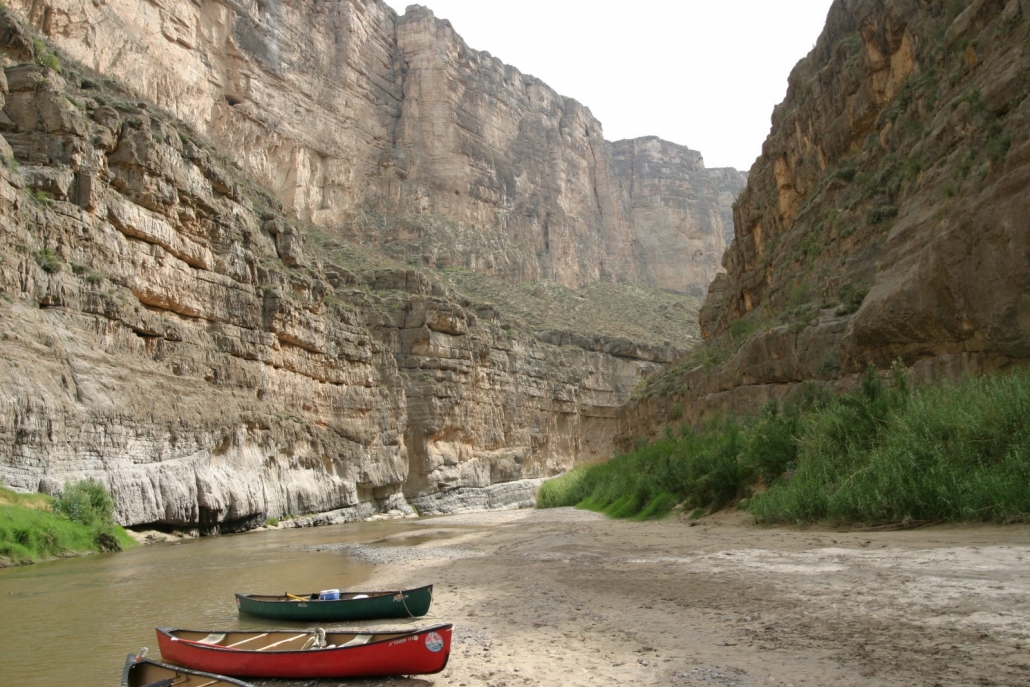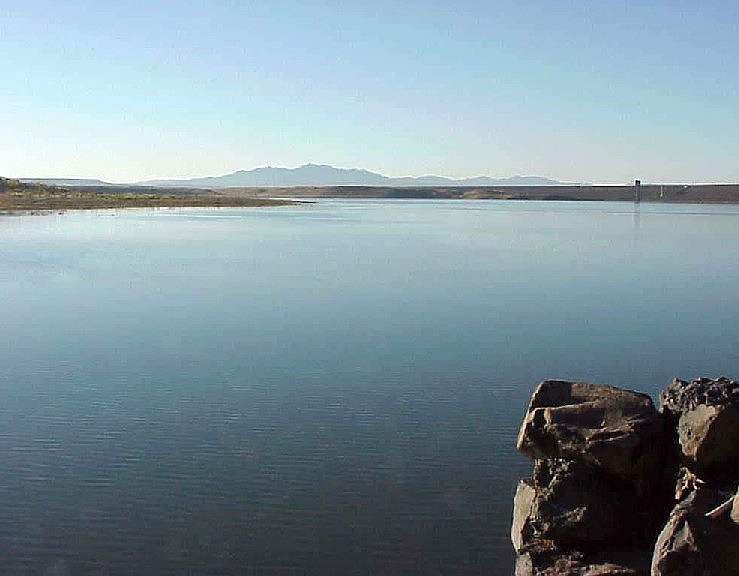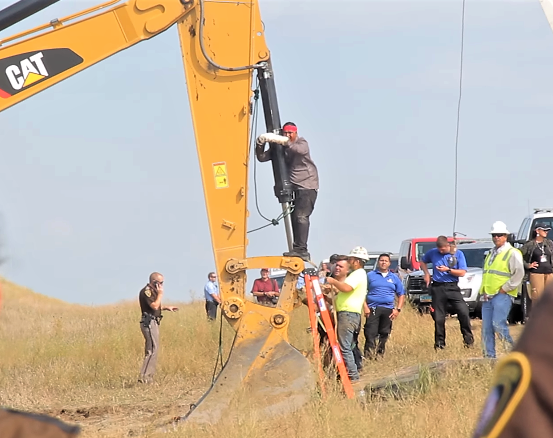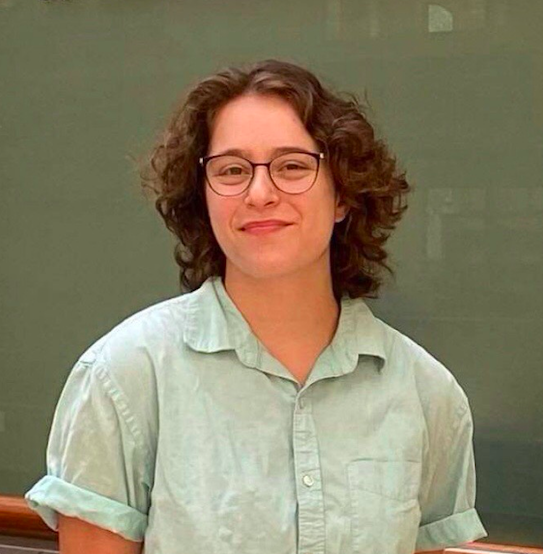Julia Bernal came of age while living in a watershed turned upside down by dams and diversions. Now an activist, she campaigns for Indigenous rights — and the water to sustain them.

Pictured at the Santa Elena Canyon in Texas, the flow of the Río Grande shrinks during the summer. Photo © iPhone Photography / Wikimedia Commons
- The combined effects of the Cochiti Dam upstream and climate change have cut the Río Grande flow to a fraction of what it once was.
- The director of Pueblo Action Alliance, an activist group, Julia Bernal is acutely aware that in arid areas like her home in the American Southwest, the fight for Indigenous rights starts with one crucial resource: water.
- To ensure that Indigenous knowledge is incorporated into water management solutions, Bernal stressed that Indigenous people, particularly women, must have a seat at the table when policies are being discussed.
By Laura Gersony, Circle of Blue — August 9, 2021
Growing up in Sandia Pueblo, on the banks of the Río Grande in New Mexico, Julia Bernal heard tales about the world of her ancestors. Elders told her that the area was home to diverse flora and fauna, the likes of which she had never seen. The river used to overflow regularly, creating small creeks and ponds, prompting the tribe to rebuild roads every few years. Her father recounted a moment from his youth when he almost biked into the river, not realizing the water had stretched so far beyond its banks.
But standing at that same spot with her father earlier this year, the river of his youth was barely imaginable to Bernal. The combined effects of the Cochiti Dam upstream and climate change have cut the river’s flow to a fraction of what it once was, and the overflowing banks from her father’s childhood are bone dry.
The director of Pueblo Action Alliance, an activist group, Bernal is acutely aware that in arid areas like her home in the American Southwest, the fight for Indigenous rights starts with one crucial resource: water.

Designed to control flooding and runoff, the Cochiti Dam has cut the flow of the Río Grande river to a fraction of what it once was in Sandia Pueblo, Bernal’s home. Photo © Pat Smith, U.S. Army Corps of Engineers / Wikimedia Commons
Bernal was raised to view water as more than just a resource to be extracted. “In my community, we view the river as a mother, having personhood, a living entity. Therefore, there’s a lot of respect and care that we, as stewards of this land and our waterways, have towards ensuring that our river is healthy,” she told Circle of Blue.
For many Indigenous groups, the well-being of the land is inseparable from that of its inhabitants. One of the 10 guiding principles of Pueblo Action Alliance is to “heal from cycles of trauma and oppression; and to heal the waters and lands”—two sides of the same coin.
“We are connected to this land. We are connected to these waters,” she said. “Violence against us is violence on the land, and violence on the land is violence on us.
Bernal was politically-minded from a young age. She was always aware of native-led resistance movements, and had an intuitive sense that the status quo had to change. But what galvanized her political consciousness were the Standing Rock protests, a sustained resistance movement of Native American communities against the Dakota Access oil pipeline, beginning in 2016.
“It was an intersectional movement: respecting Indigenous sovereignty, respecting treaties, protecting water, protecting cultural integrity, all of these things,” she said. “It wasn’t just about protecting the water: it’s the people, it’s the land, and their cultures.”
This nexus motivates Bernal to emphasize water rights in her activism. She is an advocate of the Land Back movement, which calls on the U.S. government to allow Indigenous people to continue stewarding the lands as they did before colonization. And in the American Southwest, she has taken up a new refrain: that “we can’t have land back without water back.”
“In order for the land to be fruitful, there needs to be water,” she said. “That needs to be included in what ‘land back’ means.”

In 2016, resisting the Dakota Access pipeline at Standing Rock, protestors took direct action by locking themselves to pipeline construction equipment. Photo © Desiree Kane / Wikimedia Commons
Bernal diagnoses the climate crisis as a direct result of colonialism, whose goal, she said, is to accumulate as many resources as possible. This view of the natural world lacks the ethic of reciprocity that she was taught. “All of the carbon emissions that are contributing to climate change and the climate crisis, you have to root it back to what colonialism’s goal is in the first place,” she said.
Bernal, who is working on her masters degree in hydrology and water resources, cautioned against viewing water as merely a commodity, or a force to be controlled.
“That’s why we have mismanaged water so much: we have tried to control the system, rather than living with the system,” she said. “We have to really start thinking about changing the paradigm of how we view water into something more indigenized, so that way it can benefit everyone.”
To ensure that Indigenous knowledge is incorporated into water management solutions, she stressed that Indigenous people, particularly women, must have a seat at the table when policies are being discussed. “Water spaces are predominantly white older men. There needs to be more Indigenous women in water spaces, point blank,” she said. “Something has to change.”
Bernal views herself as continuing a long tradition of activism. Members of the Pueblo Action Alliance trace their roots back to the 1680 Pueblo Revolt, an indigenous uprising against the Spanish colonial regime in Santa Fe.
“Historically, our existence has been viewed as a threat. We have resisted colonization, assimilation, up until this point. We come from a long lineage and history of ancestors who also fought for our existence,” she said.
And just as she remains grounded in the wisdom and experience of her ancestors, what keeps her going is the knowledge that her efforts to protect waterways will benefit future generations—Indigenous peoples and settlers alike.
Laura Gersony covers water policy, infrastructure, and energy for Circle of Blue. She also writes FRESH, Circle of Blue’s biweekly digest of Great Lakes policy news, and HotSpots H2O, a monthly column about the regions and populations most at-risk for water-related hazards and conflict. She is an Environmental Studies and Political Science major at the University of Chicago and an avid Lake Michigan swimmer.





